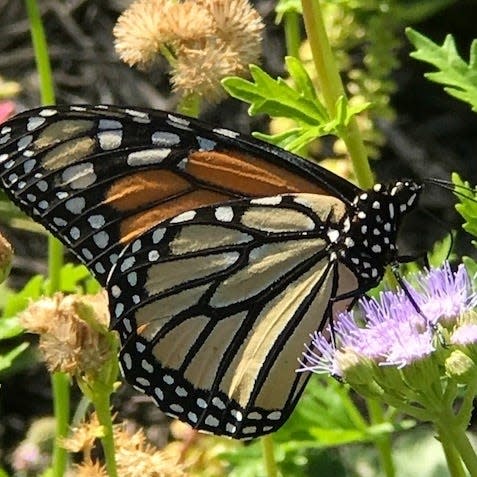Butterflies in plight: Monarch migration is in Texas. But wait, is this all of them?
The monarch migration has landed in Texas … but wait, is this all of them? Where did all the butterflies go?
For many of those who can remember back several decades, the monarchs' semiannual grand appearances have become far less impressive in recent years.
Before their decline between the mid-1990s and early 2000s, Texans could expect to see somewhere between dozens and hundreds of vibrant butterflies floating the area on any given fall day. Now, wildlife experts are concerned the very existence of the species is at stake.
Although an exact number isn’t confirmed, expert opinions range between a 30% to 90% decline since the 1990s.
“They’re not endangered yet (according to the U.S. Fish and Wildlife Service),” said Russell Martin with the Texas Parks and Wildlife Department. “They’re a candidate species, which is their way of saying, ‘Hey, we acknowledge they’re in trouble, but we don’t have the resources to make the full listing decision at the time.’”
The U.S. Fish and Wildlife service will officially determine the listing in 2024, Martin notes, although some conservation organizations have already recognized the species as endangered. The International Union for Conservation of Nature, for instance, listed the species early this summer.
Regardless of the differing statuses, it’s undeniable that the species is in trouble, Martin acknowledged. Among its biggest threats are urban development, drought and climate change.
“But what’s really driving their decline is definitely habitat loss and degradation,” Martin said. “There’s a bunch of stuff that contributed to the (long-term) decline, like the conversion of grassland to agriculture that happened in the Midwest several hundreds of years ago. But in the last 30 years, there’s been more and more herbicide and pesticide use as our farms have become more commercialized.
“And there’s really been a steep decline in the species over the last 20 or so years,” he added.
Related:In Ag. & Eco: Monarch migration, massive pumpkin, giant fish catch & U.S. gourd obsession
Monarch migration
Each year, the important pollinators trek from southern Canada through the Midwest before they land in Arkansas, Oklahoma and Texas during the early fall. That's where they stay for several weeks before heading down to the mountains of Central Mexico as they ride in ahead of major cold fronts.
While West Texas has historically never been a major part of the monarch’s migratory pathway, their appearance has been even less abundant than usual this year.
“I think we’ve probably reached our peak,” Vikram Baliga, Texas Tech Horticulture Garden and Greenhouse Manager said earlier this week. “It’s possible that some of the stragglers will get dumped out; it kind of depends on where the jet stream takes them. But it looks like they’re pushing a little bit east of us, where they likely received more rain.”
Although the species' traditional migratory corridor follows Interstate 35 from Dallas to Waco through Austin and San Antonio, Martin said West Texas is often a secondary corridor for the monarch if there’s a severe drought in Central Texas.
“They follow the flowers,” he said.
But ahead of this year’s winter migration, severe and extreme drought had already covered most of the Southern U.S. — including all of Texas — for nearly a year. This time, it was likely wiser for the butterfly species to follow its usual route than to wander the prairies of West Texas.
“A lot of times, what will bring them to the West, is if there’s a lot of flowers and forage out in the fields and out around farms and whatever else,” Baliga said. “We didn’t really have that as much this year, so the ones that would have normally ended up, instead, followed the blooming flowers a little further east.”
Milkweed for monarchs

Entomologists and other experts flowering perennial could be one of the major saving graces for the beloved species and have long encouraged those in proximity of our winged friends to plant milkweed to help rebuild the species.
The reason for this big push, Baliga said, is because the monarch primarily chooses to lays its eggs on different milkweed plants, which contain a toxin that will simultaneously strengthen their system throughout their life cycle — from caterpillar through butterfly — and protect them from predators. This natural phenomenon has prompted other butterflies species to mimic the monarch and adapt similar black and orange patterns to better ward off predators.
And while other butterfly species might forage on milkweed, they’re not going to lay eggs on the plant because of that same toxic sap that other caterpillars can't handle.
Rather, Baliga suggests building a garden of various plants and flowers that will serve an entire portfolio of pollinators — all of which are equally as important as the monarch.
“Planting milkweed is really good for the monarchs that want to lay eggs,” Baliga said. “But there are more butterflies than monarchs. A lot of times we focus on them because they have this big migration, and they’re very charismatic in certain ways. They’re popular — just like the Amazon Rainforest is popular.
"But there’s a lot of other ecosystems that are important, just like there are a lot of other butterflies that are important."
This article originally appeared on Lubbock Avalanche-Journal: Monarch migration is in Texas. But wait, is this all of them?
